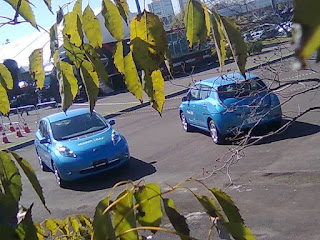The internal-combustion engine has been a reliable source of power for more than a century, and the basic operating principles are pretty much unchanged in this meantime. Compared to external-combustion machinery, such as the Watt's steam engine, the safety has been a noticeable advantage, even though it's limited to run on liquid or gaseous fuels. However, the predominance of petroleum-based fuels became a matter of concern in recent decades, not just due to environmental motivations but also because of the petroleum being a finite resource. This, and the advances in electric engines and batteries, is leading to some questionings about the viability of internal-combustion engines in the foreseeable future. However, it doesn't seem accurate to single-out engine technology as the main problem, while a better selection of renewable fuels could actually improve their environmental record.
While there has been some expectations around electric drive as a "cleaner" alternative to internal-combustion engines, especially in the automobile industry which still relies heavily on them, it's not so accurate to neglect some issues surrounding the reliability of battery-electric vehicles (BEVs) under certain operating conditions. Even though it may fare well in stop-and-go traffic, and the footprint of electric power generation is expected to go down as much as solar, tidal and wind power get widespread, there are still many concerns about the current status-quo with either a dependence on coal which is highly pollutant or hydroelectric which capacity is often compromised by unfavorable weather conditions such as longer dry periods. However, the effects of subtle weather changes on those alternative power sources is also far from negligible, and when it comes to wind power there had been some concerns about its effect on wind directions and how it would affect the migrating birds. The chemical compounds used in batteries, and the availability of raw materiais suitable to their manufacturing, had also been a subject of uncertainties due to the political allignment of certain countries with large reserves of lithium such as Bolivia.
The frequent usage of internal-combustion engines for electric power generation, either continuously or as a standby emergency setup, is another critical aspect to take in account. It's also important to remind the ease of handling inherent to most of the traditional liquid fuels, with Diesel fuel being still prevalent for that application, and the availability of gaseous fuels that could also be used, quickly turning a genset into a valuable asset in areas prone to weather-related power shortages at a higher rate. Despite it being possible to store electric power supplied by the grid during low-demand hours to use later in peak hours, and even the battery of an electric car such as the Nissan Leaf may fare as a limited power supply to the household during a shortage, gensets powered by an internal-combustion engine are still likely to remain quite common, while electric vehicles are going to keep relying heavily on government incentives as an attempt to increase their acceptance among the general public.
Other application for which the internal-combustion engine has been unbeatable is on utility boats, for which the harsh environmental conditions such as the salt mist are a matter of concern. After the Diesel engines successfully replaced the failure-prone and labor-intensive coal-fired steam engines about a century ago, there has been virtually no competition other than gas turbines. It could sound quite simple to harvest solar and wind power for a boat, not just for motion but also to supply power for communication and navigation devices such as a radio and a GPS, or comfort features, but it would still be subject to eventual weather changes and compromise the power supply. The energy density of an internal-combustion powerplant with all the fuel, lube oil and eventually other fluids required is usually still more favorable than what could be achieved with an all-electric setup (excluding on-board generation from solar or wind power in order to keep it more predictable), which is more suitable for such a weight-sensitive application.
Another aspect that should be always taken into account instead of pushing electric drive as the one-size-fits-all solution is the closure of the carbon cycle, which is actually way more effective with the internal-combustion engines. Their suitability to operate with renewable hydrocarbons is a valuable asset, considering that post-combustion CO² has a shorter half-life than methane which is the main component of Natural Gas and is methabolised more easily by vegetable stocks, either agricultural crops and pastures or forests. We must consider that organic matter is always going to rot away, so it would be better to keep it under control and take benefit from any energy that could be harvested, which includes ethanol that can be brewed out of virtually any starch, sugar, molasses or even cellulose, and the biomethane that is released by a wider range of feedstocks. Due to the technology required to make a spark-ignited engine run on those fuels being already commercially-available, sure there is some hope for internal combustion even in this post-Dieselgate world...
With operating principles remaining nearly unaltered for more than 100 years, internal-combustion engines have been a reliable power supply not just for mobility but also for many other activities of the mankind. Addressing issues concerning to the quality of fuels and lube oils supplied to those amazing machines seems to be actually more effective in order to claim a better environmental record for them, in order to ensure the best balance of sustainability and economic viability Even though it might seem like we're desperately attempting to stick with the past, it becomes hard to deny how suitable the internal-combustion engine is going to remain in a foreseeable future.
Wednesday, September 20, 2017
Monday, September 04, 2017
One of the most unconventional food-trucks in Brazil
I saw it a few times in Florianópolis, capital of Santa Catarina state. I have no clue how the driver is able to look around while driving, but it does drive. I took this picture in the Pantanal neighborhood, but I have seen it before in Rio Tavares. It's been built around a Ford Corcel, which is a local derivative of the Renault 12 that was under development when Ford purchased the assets of Willys-Overland, which represented Renault interests in Brazil.
 |
| Picture merely illustrative |
Subscribe to:
Comments (Atom)
















